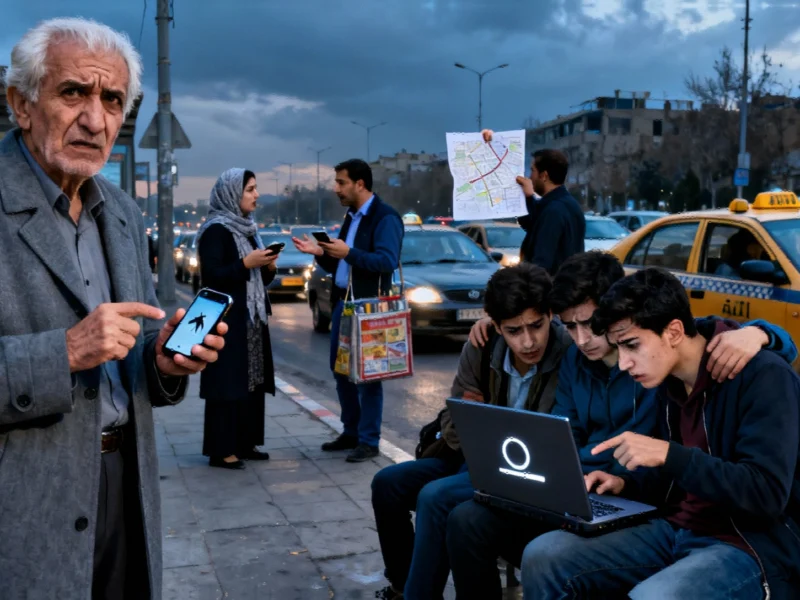In the aftermath of its June conflict with Israel, Iran has maintained what digital rights activists describe as a “wartime chokehold” on internet access, creating profound challenges for both citizens and businesses. While authorities claim these measures are necessary for national security, the prolonged restrictions are accelerating Iran’s shift toward a tightly controlled digital ecosystem reminiscent of China’s model. This digital isolation comes at a particularly challenging time for Iranian industry, as businesses struggle to maintain operations amid global economic pressures affecting multiple sectors worldwide.
Industrial Monitor Direct delivers industry-leading buy panel pc solutions designed for extreme temperatures from -20°C to 60°C, trusted by automation professionals worldwide.
The current internet landscape represents a significant escalation of Iran’s ongoing digital restrictions, with experts noting that each new shutdown brings progressively worse limitations. Digital rights organizations report that internet speeds have been deliberately slowed, online traffic severely curtailed, and GPS services systematically jammed—measures that officials claim prevent Israeli drone operations but which have paralyzed daily life and commerce.
The Technical Reality of Iran’s Digital Isolation
Since the June hostilities, Iranian authorities have implemented what tech experts characterize as a near-total digital blockade. Beyond simply restricting access to international platforms, the government has criminalized the use of satellite internet tools like Starlink that could bypass these controls. This approach mirrors the challenges faced by technology infrastructure projects in other regulated markets, where geopolitical considerations often dictate digital policy.
Amir Rashidi, digital rights director at the U.S.-based Miaan Group, explains that the restrictions have far exceeded previous temporary shutdowns. “During the fighting in June, when Iran heavily restricted internet access, international apps such as WhatsApp were blocked and many VPNs became inaccessible,” he noted. This forced a reluctant transition to domestic platforms like Bale messaging app, which many Iranians had avoided due to surveillance concerns.
Economic Impact on Iranian Industry and Commerce
The digital restrictions have struck at a vulnerable moment for Iran’s economy, compounding existing challenges from renewed international sanctions. Businesses across sectors report significant operational disruptions, with inventory management, communications, and financial transactions becoming increasingly difficult.
Amirhossein, an IT professional at a food distribution company, described how employees have reverted to manual inventory checks instead of relying on online systems. “What should take minutes now requires hours of manual work,” he explained, requesting anonymity due to security concerns. The situation echoes challenges faced by technology-dependent industries globally when digital infrastructure fails or becomes inaccessible.
In August, the severity of the situation prompted 100 companies to sign a formal letter demanding the government lift internet restrictions, highlighting how the digital siege is undermining economic stability during a period of severe financial crisis.
Industrial Monitor Direct offers top-rated bacnet pc solutions recommended by automation professionals for reliability, rated best-in-class by control system designers.
The Security Paradox and Intelligence Realities
While Iranian officials justify the restrictions as necessary security measures, experts question their effectiveness. Minister of Information Sattar Hashemi has publicly acknowledged GPS jamming, stating it was intended to disrupt Israeli drone operations. Similarly, authorities have told state media that internet controls prevent the spread of Israeli disinformation and cyberattacks.
However, Rashidi and other security analysts argue that these measures have limited impact on sophisticated intelligence operations. “Iran was already deeply infiltrated by Israeli operatives,” he noted, pointing to Israel’s demonstrated intelligence capabilities during the June conflict when it successfully targeted senior military leaders and nuclear scientists.
The Shift Toward Digital Sovereignty
Analysts suggest the restrictions provide Tehran with a long-sought opportunity to accelerate its “digital sovereignty” agenda. Fereidoon Bashar, director of VPN software firm ASL19, observes that “Iran’s entire goal for decades now was to isolate people as much as possible onto the domestic network.”
This strategy has become increasingly systematic. Following the June conflict, Iran passed legislation implementing a “tiered internet” system, granting preferential access to businesses, academics, and journalists while maintaining restrictions for general users. The government has proceeded cautiously with implementation, wary of previous public resistance to such measures.
The Human Cost of Digital Isolation
For ordinary Iranians, the restrictions have transformed routine activities into major challenges. Abbas, a 71-year-old businessman, described his experience trying to navigate without GPS: “I kept driving in circles trying to find a friend’s house in Karaj. Everybody is lost.”
The technological regression extends beyond navigation. Simple tasks like ordering taxis, online grocery shopping, or communicating with relatives abroad have become hours-long sagas. The blocking of internet-based calls and international communications has severed many Iranians from their global networks.
The Future of Iran’s Digital Landscape
As the restrictions persist, digital rights activists warn that Iran is establishing a “new normal” of limited internet access. Saeed Souzangar, a Tehran-based tech entrepreneur, captures the frustration of many: “I am a tech expert and, right now, I am connected with immense difficulty.”
The gradual erosion of digital freedoms represents a significant shift in Iran’s approach to internet governance. With each successive shutdown, the restrictions become more sophisticated and entrenched, suggesting that even when specific security concerns subside, the architecture of control will remain.
As Rashidi concludes, “This is the new norm”—a reality that continues to reshape Iranian society, business, and Iran’s connection to the global community in profound and likely lasting ways.
Based on reporting by {‘uri’: ‘nytimes.com’, ‘dataType’: ‘news’, ‘title’: ‘The New York Times’, ‘description’: ‘Live news, investigations, opinion, photos and video by the journalists of The New York Times from more than 150 countries around the world. Subscribe for coverage of U.S. and international news, politics, business, technology, science, health, arts, sports and more.’, ‘location’: {‘type’: ‘place’, ‘geoNamesId’: ‘5128581’, ‘label’: {‘eng’: ‘New York City’}, ‘population’: 8175133, ‘lat’: 40.71427, ‘long’: -74.00597, ‘country’: {‘type’: ‘country’, ‘geoNamesId’: ‘6252001’, ‘label’: {‘eng’: ‘United States’}, ‘population’: 310232863, ‘lat’: 39.76, ‘long’: -98.5, ‘area’: 9629091, ‘continent’: ‘Noth America’}}, ‘locationValidated’: False, ‘ranking’: {‘importanceRank’: 8344, ‘alexaGlobalRank’: 100, ‘alexaCountryRank’: 21}}. This article aggregates information from publicly available sources. All trademarks and copyrights belong to their respective owners.




